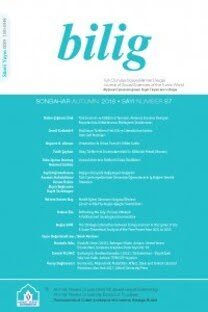Ankara, Toronto ve Priştina’daki Üniversite öğrencilerinin risk alma davranışları açısından karşılaştırılması
___
Alexander, Cherly S. et al. (1990). “A Measure of Risk Taking for Young Adolescents: Reliability and Validity Assessments”. Journal of Youth and Adolescence 19 (6): 559-569.Alikaşifoğlu, Müjgan et al. (2004). “Violent Behaviour Among Turkish High School Students and Correlates of Pysical Fighting”. The European Journal of Public Health 14 (2): 173-177.
Almqvist, Kjerstin ve G. Broberg Anders (2003). “Young Children Traumatized by Organized Violence Together With Their Mothers - The Critical Effects of Damaged Internal Representations”. Attachment and Human Development 5 (4): 367-380.
Anastasijevic, Dejan (2008). “Birth of a nation”. Time (Avrupa baskısı), 3 Mart 2008: 48.
Arnett, J. Jeffrey (1992). “Reckless Behavior in Adolescence: A Developmental Perspective”. Developmental Review 12 (4): 339-373.
Bayar, Nalan ve Melike Sayıl (2005). “Brief Report: Risk-Taking Behaviors in A Non-Western Urban Adolescent Sample”. Journal of Adolescence 28 (5): 671-676.
Benjamin, Woan Jue et al. (2001). “Conflict and Childhood Friendship in Taiwan and Canada”. Canadian Journal of Behavioural Science 33: 203-211.
Burcu, Esra (2003). “Alcohol and Drug Use in Young Apprentices: Effect of Social Control in the Family”. Journal of Youth and Adolescence 32: 291-299.
Bülbül Selda Fatma Hizel vd.(2008). “Health Risk Behaviors of Students in An Anatolian University”. Pediatrics 121: 89.
Byrnes, James P., David C. Miller and William D. Schafer (1999). “Gender Differences in Risk Taking: A Meta-Analysis”. Psychological Bulletin 125 (3): 367-383.
Cindoğlu, Dilek (1997). “Virginity Tests and Artificial Virginity in Modern Turkish Medicine”. Women’s Studies International Forum 20 (2): 253-261.
Cole, Ester ve Robert S. Brown (2002). “Psychological Needs of Post-War Children in Kosovo: A Preliminary Analysis”. School Psychology International 23(2): 131-147.
DiTommaso, Enrico, Cyndi Brannen and Melissa Burgess (2005). “The Universality of Relationship Characteristics: A Cross-Cultural Comparison of Different Types of Attachment and Loneliness in Canadian and Visiting Chinese Students”. Social Behavior and Personality 33 (1): 57-68.
Duyan, Veli ve Gülsüm Duyan (2005). “Turkish Social Work Students' Attitudes Toward Sexuality”. Sex Roles 52: 697-706.
Fiske, Alan P. (2002). “Using Individualism and Collectivism to Compare Cultures - A Critique of the Validity and Measurement of the Constructs: Comment on Oyserman et al. (2002)”. Psychological Bulletin 128 (1): 78–88.
Gardner, Margo ve Laurence Steinberg (2005). “Peer Influence on Risk Taking, Risk Preference, and Risky Decision Taking in Adolescence and Adulthood: An Experimental Study”. Developmental Psychology 41 (4): 625–635.
Gonzales, Jeanette et al. (1994). “Adolescents’ Perception of Their Risk-taking Behavior”. Adolescence 29: 701–709.
Göregenli, Melek (1995). “Kültürümüz Açısından Bireycilik-Toplulukçuluk Eğilimleri: Bir Başlangıç Çalışması (Individualist-Collectivist Tendencies in a Turkish Sample: A Preliminary Report)”. Türk Psikoloji Dergisi 10: 15-24.
Gullone, Eleonora et al. (2000). “The Adolescent Risk-Taking Questionnaire: Development and Psychometric Evaluation”. Journal of Adolescent Research 15 (2): 231-250.
Hofstede, Geert (1980). Culture’s Consequences: Comparing Values, Behaviors, Institutions and Organizations Across Nations. Thousand Oaks: Sage Publications.
İlkkaracan, Pınar (1998). “Exploring the Context of Sexuality in Eastern Turkey”. Reproductive Health Matters 6 (12): 66-75.
İmamoğlu, E. Olcay (1998). “Individualism and Collectivism in a Model and Scale of Balanced Differentiation and Integration”. The Journal of Psychology 132 (1): 95-105.
——— (2003). “Individuation and Relatedness: Not Opposing but Distinct and Complementary”. Genetic, Social and General Psychology Monographs 129 (4): 367-402.
Kağıtçıbaşı, Çiğdem (2005). “Autonomy and Relatedness in Cultural Context Implications for Self and Family”. Journal of Cross-Cultural Psychology 36 (4): 403-422.
Kandiyoti, Deniz (1988). “Bargaining with Patriarchy”. Gender and Society 2(3): 274-290.
Lightfoot, Cynthia (1997). The Culture of Adolescent Risk-Taking. New York: Guilford Press.
Moore, Susan ve Doreen Rosenthal (1993). Sexuality in Adolescence. London: Routledge.
Öngen, E. Demet (2007). “The Relationships Between Sensation Seeking and Gender Role Orientataions Among Turkish University Students”. Sex Roles 57: 111-118.
Özbay, Özden ve Yusuf Z. Özcan (2006). “A Test of Hirschi’s Social Bonding Theory: Juvenile Delinquency in the High Schools of Ankara, Turkey”. International Journal of Offender Therapy and Comparative Criminology 50: 711-726.
Rolison, Mary R. ve Avraham Scherman (2002). “Factors Influencing Adolescents’ Decisions to Engage in Risk-Taking Behavior”. Adolescence 37: 585-596.
Selçuk, Emre vd. (2005). “Yetişkin Bağlanma Boyutları İçin Yeni Bir Ölçüm: Yakın İlişkilerde Yaşantılar Envanteri-II’nin Türk Örnekleminde Psikometrik Açıdan Değerlendirilmesi (A New Measure for Adult Attachment Styles: The Psychometric Evaluation of Experiences in Close Relationships-Revised (ECR-R) on a Turkish sample)”. Türk Psikoloji Yazıları 8: 1-11.
Siegel, Alexander W. et al. (1994). “Adolescents’ Perceptions of the Benefits and Risks of Their Own Risk Taking”. Journal of Emotional and Behavioral Disorders 2 (2): 89-98.
Sorkhabi, Nadia (2005). “Applicability of Baumrind's Parent Typology to Collective Cultures: Analysis of Cultural Explanations of Parent Socialization Effects”. International Journal of Behavioral Development 29 (6): 552-563.
Sümer, Nebi ve Derya Güngör (1999). “Çocuk Yetiştirme Stillerinin Bağlanma Stilleri, Benlik Değerlendirmeleri ve Yakın İlişkiler Üzerindeki Etkisi (The Role of Perceived Parenting Styles on Attachment Styles, Self-Evaluations and Close Relationships)”. Türk Psikoloji Dergisi 14 (44): 35-58.
Taylor, D. Ronald ve Gülter Oskay (1995). “Identity Formation in Turkish and American Late Adolescents”. Journal of Cross-Cultural Psychology 26 (1): 8-22.
Tonkins, Roger S. (1987). “Adolescent Risk-Taking Behavior”. Journal of Adolescent Health Care 8: 213-220.
Triandis, Harry C. (1995). Individualism and Collectivism. Boulder, CO:Westview Press.
Triandis, Harry C., Christopher McCusker ve Harry Hui (1990). “Multimethod Probes of Individualism and Collectivism”. Journal of Personality and Social Psychology 59: 1006-1020.
Yetim, Ünsal (2003). “The Impact of Individualism/Collectivism, Self-Esteem and Feelings of Mastery of Life Satisfaction Among the Turkish University Students and Academicians”. Social Indicators Research 61: 297-317.
- ISSN: 1301-0549
- Yayın Aralığı: 4
- Başlangıç: 1996
- Yayıncı: Ahmet Yesevi Üniversitesi Mütevelli Heyet Başkanlığı
Osmanlı tazma eserleri ve Türkiye’de yazma eser kütüphaneciliği
Gülay ARIKAN, Tuğça TACAOĞLU, Seçil ERDOĞAN
Karadeniz’de çevre sorunları ve işbirliğine yönelik yerel, bölgesel perspektifler
Gülay ARIKAN, TUĞÇA POYRAZ TACOĞLU, Seçil ERDOĞAN
Osmanlılarda malî denetim aracı olarak muhasebe icmal defterleri: Trabzon örneği
Örgütsel adaletin bilgi paylaşımı üzerine etkisi: İlaç sektörü çalışanlarına yönelik bir araştırma
Hikâye ve Romanlarda sembol dilinin görüntüleri üzerine bir değerlendirme
